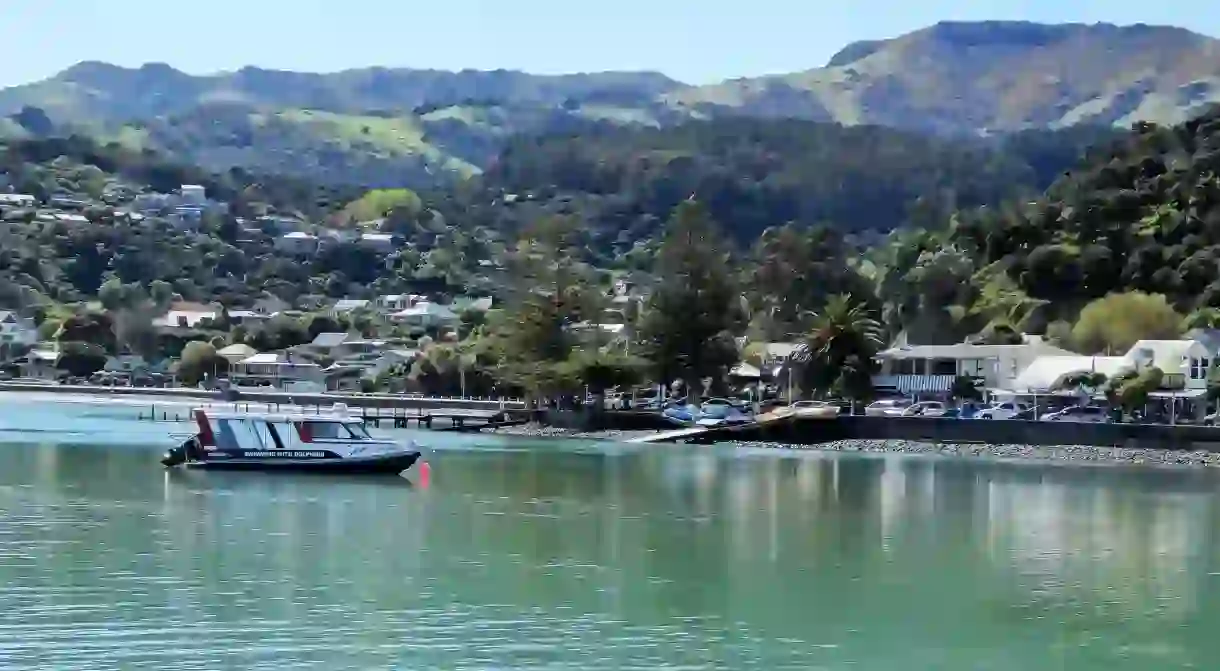A Traveller's Guide To Akaroa & Banks Peninsula, New Zealand

With two beautiful harbours, a collection of small bays and its charming historic villages, it’s easy to see why Banks Peninsula is loved by those exploring the eastern shores of New Zealand’s South Island. The township of Akaroa – and the mass assortment of wildlife that resides within its shores – is a strong asset, but the area’s appeal goes well beyond this.
The peninsula is composed of various ancient volcanoes. Over several million years, eruptions and erosion in the volcanic complex carved the picturesque valleys, tumbling hills, verdant pastures and punctuating bays that we see today.

Interestingly, the peninsula’s ragged features famously led Captain James Cook to mistake the area for an entirely separate island. If you ever get the chance to see this majestic setting from up in the skies, you might understand the explorer’s oversight: the sprawling nature of its landmass is quite remarkable.

Many people tend to make their way to Banks Peninsula after spending some time in Christchurch. The South Island’s largest city sits just north of the peninsula, which is why this is such convenient day trip destination for holidaying locals and tourists alike. Many opt to drive the scenic countryside roads to Akaroa, which is arguably the most popular stopover in the vicinity; tour buses and shuttles also take people along Banks Peninsula and into the famous township.

Experienced cyclists can get a different perspective of the area’s natural features. A trip across the Little River Rail Trail – a long-distance track that begins in the Christchurch suburb of Hornby and ends just outside the Little River – passes through a series of lakes, quarries and rivers before reaching its final destination. The second to the last stretch of the journey, just outside Lake Elsmere, also provides some incredible views of the Southern Alps from a faraway distance.

On that note, there are quite a few walking and hiking routes dotted around the Banks Peninsula. Those with an affinity for multi-day tramping might choose to explore the Te Ara Pātaka/Summit Walkway, which connects the Gebbies Pass in the Lyttelton crater to Hilltop in the Akaroa crater. From Hilltop you can also access the Pigeon Bay Walkway – a five-hour hike that will expose you to some of the most spectacular coastal vistas as well as a series of native trees and plant life.

Beyond these stunning landscapes, it is the accessibility to native wildlife that brings the masses to Akaroa and Banks Peninsula. Cruises along Akaroa Harbour are regular summer features, and people are also wont to kayaking and sailing the oceans in order to catch a glimpse of the critters that call the area home. This is one of the best places to get up close to New Zealand’s endangered Hector’s dolphin, several penguin colonies as well as the native fur seals that sunbathe on the rocky shores.

But the town of Akaroa is remarkable not just for its marine residents: it is also noteworthy for its compelling history and heritage. Akaroa is the Canterbury region’s oldest town and was founded in 1840 by French settlers. It is believed that French interest in the area propelled the English to speed up its annexation of New Zealand. By the time French settlers arrived, the signing of the Treaty of Waitangi has taken place, thus cementing the country’s place as a British colony. To this day, the British-French duality is evident throughout the township, as most of Akaroa’s streets still have French names, providing a contrast to the 19th-century colonial cottages that surround it.

It’s also worth noting that the peninsula offers plenty of wildlife encounters outside the Akaroa Harbour. For instance, you can find colonies of yellow-eyed and white-flippered penguins, as well as seals, sea birds, visiting orcas and dolphins around the Pohatu Marine Reserve. This is another popular spot in the Banks Peninsula for kayaking, though you can view these critters from drier ground too. The reserve is set among Flea Bay; you do need to drive along a steep, unsealed road to reach it, but it’s worth the effort just to immerse yourself in the dramatic landscapes that come to fore.

The peninsula’s outer bays are also worth exploring. Okains Bay and Le Bons Bay are probably the best renowned. Both offer quite safe swimming conditions and have their fair share of campsites to accommodate their summer visitors. Okains Bay is also noteworthy for its historic affinities. The local museum is filled with interesting Maori treasures and relics from New Zealand’s colonial past.

Other sheltered bays you might want to visit include Governor’s Bay, the Diamond Harbour, French Farm, Takamatua and Duvauchelle. Each has its own distinct personality, so it’s up to you to decide which appeals the most.
At the end of the day, Akaroa and the wider Banks Peninsula offer something for every kind of nature lover out there – with a bit of historic charm thrown into the mix. That should be enough reason to want to delve into these horizons quite closely.














